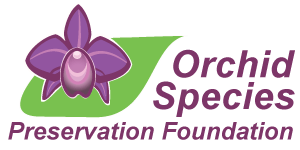Orchid Distribution & Types
Orchids are found on every continent with the exception of the arctic poles. The approximate occurrence of orchid species is given in the figure below, with South America by far having its greater share with over a third of the entire world’s species being found on that continent.
Orchid Types
Orchid species have adapted to various habitats depending on where they are found in the world. Orchids can also interchange their habitat depending on the circumstances in which they find themselves. For example, an epiphytic seed can land and grow in a well drained but still moist area, like a rock next to a stream if there is enough moisture to sustain its growth.
Approximately 25% of all orchids are terrestrial, or ground orchids. They live in soil in different habitats, such as the forest floor, grassland, woodland, or bogs. Their underground parts, called tuberoids store food reserves to ensure the development of new shoots at the beginning of the next growing season. The bee orchids in the Ophrys genus are a good example of a terrestrial orchid.
Below – Ophrys [Oph.] apifera can be found across Europe and into the Near East and Northern Africa around the Medditerrean Sea.
[x_image type=”rounded” src=”https://orchidspecies.ca/wp-content/uploads/2018/03/Picture1.jpg” alt=”” link=”false” href=”#” title=”” target=”” info=”none” info_place=”top” info_trigger=”hover” info_content=””]
70-75% of all orchid species are epiphytic orchids. They live on trunks and branches of shrubs and trees. There is a widespread misconception that orchids are parasitic, which is not the case! They receive nutrients from the air and depend on rain and mist for their water supply. They use the host tree to gain greater access to light in the forest canopy.
Phalaenopsis [Phal.] schilleriana is found in the Philippines on Luzon Island and on the eastern shores of adjacent islands. It is found at 0-1500 ft. (0-457 m) growing high on tree trunks and on high branches. Less than 5% of all orchid species grow on rock faces, and these are called lithophytes. The leaves of lithophytic orchids are often quite fleshy. Their pseudobulbs, which are a part of the plant specifically modified for the storage of energy and derived from the part of the stem between two leaf nodes, carry the plant through any prolonged dry spell that might occur.
Other terrestrial orchids include the Paphiopedilum, or Slipper Orchid as well as probably the best known of this type, the Phragmipedium. Since in nature the lithophytes obtain their nutrients in a similar way as the epiphytes, their culture is the same. In each case, nutrients are washed down the surface of the tree bark, or down the rock face to be absorbed by the orchid’s firmly clinging roots. While some roots remain exposed, others grow into rock cracks and crevices and feed on the natural fungal spawn, called mycelium that exists there. Oncidiums in particular, often produce dense mats of fine roots for this purpose, and they live on rocks where the surface provides a good place for germination and attachment of seedlings. Only a few orchids are exclusively lithophytes, while most will also be able to develop as epiphytes or terrestrials.
[x_image type=”rounded” src=”https://orchidspecies.ca/wp-content/uploads/2020/05/Picture2.jpg” alt=”” link=”false” href=”#” title=”” target=”” info=”none” info_place=”top” info_trigger=”hover” info_content=””]
In the astonishing world of botany, the saprophytic orchids comprise approximately less than 5% of all species, and are different from others because they do not carry chlorophyll. Therefore, they need to find food from the organic matter on the forest floor and through the help of mycorrhizal fungi. Saprophytic orchids will allow mycorrhizal fungi to live inside the tubers or the roots. The fungi will emit an enzyme to digest the organic matter, and will in turn bring about the nutrition needed for the orchid. Water and sugar from the orchid are elements given to the fungi in return. The Western Spotted Coral root Corallorhiza [Corallz.] maculata pictured below is found across most of North America, growing in moist shady woods on rocky slopes in rich decaying humus and rotten leaves at elevations up to 3700 meters.
[x_image type=”rounded” src=”https://orchidspecies.ca/wp-content/uploads/2018/03/Picture3.jpg” alt=”” link=”false” href=”#” title=”” target=”” info=”none” info_place=”top” info_trigger=”hover” info_content=””]
Finally, there is a least one orchid genus, Rhizanthella, that lives mostly underground. There are currently three species associated with this genus. The photograph below is Rhizanthella [Rhi.] gardneri, also known as Western Underground Orchid, which was discovered in the spring of 1928 in the wheatbelt of Western Australia. The white leafless plant is made up of a fleshy underground storage stem or tuber, which produces flower heads consisting of around 150 tightly packed, tiny flowers. Unlike any other orchid in Australia, the Western Australian underground orchid remains completely underground for its entire life. Not being able to obtain the sun’s energy, it instead feeds on a shrub called the Broom Honeymyrtle. The orchid is linked to the brush by a mycorrhizal fungus named Thanatephorus gardneri.
[x_image type=”rounded” src=”https://orchidspecies.ca/wp-content/uploads/2018/03/Picture4.jpg” alt=”” link=”false” href=”#” title=”” target=”” info=”none” info_place=”top” info_trigger=”hover” info_content=””]
This particular orchid is a myco-heterotroph as it relies completely on the honeymyrtle and fungus for its nutrients and carbon dioxide. Having received this from the fungus, the plant is then able to convert the water, nutrients and carbon dioxide into the energy needed for growth and maintenance. The plant blooms in May and June measuring 2.5-3 cm (1-1 1⁄4 in). The flower heads contain 8 to 90 small dark maroon flowers.
Rhizanthella gardneri reproduces vegetatively producing three daughter plants. They also undergo sexual reproduction. Moreover, underground insects, such as termites and gnats are attracted by the flower’s fragrance and pollinate them. The pollinated flower matures within six months. Of all flowers studied, these were not dispersed and eventually decayed, thus releasing their seeds. It may be, however, that native marsupials were important dispersal agents too, but substantial findings are hard to come by as only 19 mature specimens of the orchid are known to currently exist in the wild, and only 300 specimens have been collected to date.
